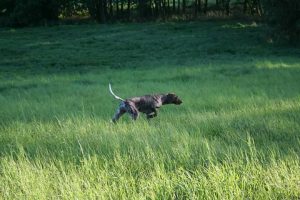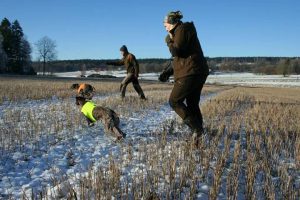We are Losing Legendary Methods (Fieldwork 1) – By T. Mostert
Tok Mostert, a Professional Hunter from South Africa, now living in Sweden, is sharing his writings on dog training with us. You can start reading them from Part 1 here.
We are Losing Legendary Methods (Fieldwork 1) – By T. Mostert
This is the single most rewarding discipline for a HPR owner or trainer. Often called the Formula 1 of the dog world, our little “machines” flying over a field, head high and then that sudden dead stop into a rock solid point. A good advance into a sit and the bird gets dropped from the sky, dog marks perfectly, retrieve is brilliant and at the end of the day you get a first prize!! Yeah, I dream too, because getting to this point takes more time and patience than any other disciplines.
Many dogs run well, many dogs find birds, many dogs are steady on point, many dogs have a good advance and many still a good retrieve. Putting it all together in ONE DOG is where it gets very, very complicated! Field trials rules, criteria and regulations are different for HPR’s in Scandinavia, Europe and the USA, but we all want our dogs to find birds, point them and be steady. I cannot speak for other test methods, I train for our field test and our criteria. Some of what I say will not be applicable to you and it will not make sense in why we do it the way we do it. I don’t like ‘kicking up birds” myself and I believe it is easier to have your dog stand still when you ” kick up” birds than to stop a dog after sending him to put the bird on the wing, it does not mean I am right and others are wrong, to each his own. Train within your framework.

There are those that believe you give a young dog birds and when he shows potential you teach him to run a proper pattern. I did not do it that way, as said before I was new to this two years ago and I taught Flake to run a pattern long before I got her onto birds on a regular basis. The single biggest problem with my method with the result that Flake ran, she did not hunt, not her mistake, but mine. She was doing what I told her to do and taught her to do. In hindsight I will use a combination of birds and teaching a dog to run a pattern at the same time. A dog that gets “fed” to many birds too early will not run as hard as he should, he will think it is easy hitting birds, more on that later.
To make it more structured, I will start with how to teach a dog to run a pattern and how to correct and steer the dog. I do not start a dog on field training that is too young, joints, ligaments and so on can be permanently damaged! Do not run a too young dog with another young dog, start your dog alone.
Exhaustion is a real danger, low blood sugar (hypoglycemia) and dehydration will kill your dog, learn the signs and keep a close watch. Young dogs rely on their owners to take care of them. Do not train field if you cannot stop or recall your dog, those who are saying “screw you” right now have not seen a dog run over. If you do run them without a stop or recall in place, run them in a fenced area or a area that has no cars or trains for 5 kms. Finished preaching let’s get to patterns.

To teach a dog to run a pattern is fairly easy, to teach a dog to run the desired pattern is harder, a dog that can adjust his pattern depending on terrain and prevalent weather conditions is a very smart dog.
I have seen many dogs on trails that are released, run straight ahead of the handler for 200 or 300 meters, then make a left or right turn head out 100-200 meters, turn left or right and head straight back to the handler before they start running a haywire pattern. I have seen dogs run the boundaries of a field only, educated dogs whose handlers trained too hard on the boundaries and not enough on the fields.There is nothing more funny for a young dog to go out and run freely, use that energy by training the dog to run a pattern. One method of doing this is by going to a field that is 50 meters wide and maybe 200 meters long. You can use larger fields, but your dog will run less pattern and you are trying to teach him to run a pattern. It works best with two people or, if you can run and keep running, you can try by yourself, I did a lot of that!
Let’s say you have the 50×100 field and you have two people. Always start training with the wind in the dogs face. Start both people and the dog in the centre of the field, release the dog and both people move in opposite directions, each to one side of the field, right at the edge on each side. I like to take a few steps back after I reach my end and then I call the dog in, this teaches the dog to cover every edge, do not expect a young dog to do this every time by itself. Then I start walking forward on the edge of the field, the other person should be able to see when the dog reaches me after I called him in. They now call the dog to them, remember to keep walking forward! The person that does the call in should not call in too soon or too late, timing is everything. Continue calling in the dog from one person to the other while walking at a steady pace towards the end of the field, the dog will eventually turn by itself. Do not let the dog turn short on either side! Once they start getting tired, they tend to turn short, the person that has the dog closest to them when he turns short should call the dog back! Please, please do not forget to heap praise on the dog when he gets to your side! He is doing what you want him to do! Do not do this for more than 10 minutes with a young dog, take a 30 minute break or longer if you intend repeating the exercise. Do not push the dog too hard in the beginning of its training on field!
Doing the same exercise alone is possible, but harder, I ran from one side to the other with the Flake, she would beat me to the other side every time, I could turn short! I had one advantage with Flake when I started pattern training, she could already take directions with hand signals (arms) and with the whistle. A judge once told me that a dog cannot read arm signals, he is wrong. Some dogs take to the pattern easy, some dogs take a little more time and some dogs just don’t get taught right. A dog that enjoys your company will follow you, no matter how hard he runs, he will keep an eye on you every now and then, a young dog even more so. Use this, when the dog reaches a point where you are happy for him to turn, turn and walk in the opposite direction (always forward), make sure your back is to the dog, do not walk backwards! You do not need to be as fast as the dog, if he passes you keep walking in the same direction until the dog reaches your chosen turning point, turn and walk in the opposite direction.